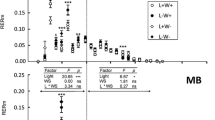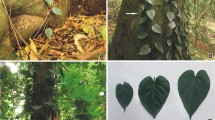Abstract
The intriguing mathematical properties of leaf phyllotaxis still attract scientific attention after centuries of research. Phyllotaxis, and in particular the divergence angle between successive leaves, have been frequently interpreted in terms of maximization of light capture, although certain model simulations of light capture by vertical shoots revealed minor effects of phyllotaxis in comparison with the effect of other morphological features of the plant. However, these simulations assumed a number of simplifications, did not take into account diffuse light, and were not based on real plants with their natural range of morphological variation. This study was aimed at filling these gaps by examining the influence on light harvesting of shoot architecture and divergence angle in four species with spiral phyllotaxis (Quercus ilex, Arbutus unedo, Heteromeles arbutifolia and Daphne gnidium) with a realistic 3-D model (Y-plant). A wide range of divergence angles (from 100° to 154°) was observed within each species, with 144° being the most frequent one. These different divergence angles rendered very different vertical projections of the shoot due to contrasting patterns of leaf overlap as seen from above, but they rendered indistinguishable light interception efficiencies (Ea). Setting the leaves with an opposite-decussate phyllotaxis led, however, to a 40–50% decrease of Ea. The interplay of internode length, leaf size and shape, and leaf elevation angle led to significant species differences in Ea. Thus, only particular phyllotaxis (e.g., decussate) might be functionally inefficient under certain combinations of the various morphological variables that influence light capture of a shoot.
Similar content being viewed by others
References
Adler I., Barabé D. and Jean V. 1997. A history of the study of phyllotaxis. Annals of Botany 80: 231–244.
Alados I., Foyo-Moreno I., Olmoa F.J. and Alados-Arboledas L. 2003. Relationship between net radiation and solar radiation for semi-arid shrub-land. Agricultural and Forest Meteorology 116: 221–227.
Douady S. and Couder Y. 1996. Phyllotaxis as a dynamical self organizing process Part I: the spiral modes resulting from time-periodic iterations. Journal of Theoretical Biology 178: 255–274.
Fleming A.J. 2002. Plant mathematics and Fibonacci's flowers. Nature 418: 723.
Givnish T.J. 1986. Biomechanical constraints on crown geometry in forest herbs. In: Givnish T.J. (ed.), On the economy of plant form and function. Cambridge University Press, New York, New York, USA, pp. 525–584.
Guerreiro J. and Rothen F. 1995. A global approach to botanic patterns. Journal of Theoretical Biology 176: 233–245.
Honda H. and Fisher J.B. 1978. Tree branch angle: maximizing effective leaf area. Science 199: 888–889.
Jean R.V. 1994. Phyllotaxis: a systematic study in plant morpho-genesis. Cambridge University Press, Cambridge, UK.
Jean R.V. and Barabé D. 1998. Symmetry in plants. World Scientific Publishing Co. Pte. Ltd., Singapore.
Klar A.J.S. 2002. Plant mathematics: Fibonacci's flowers. Nature 417: 595.
Niklas K.J. 1986. Computer-simulated plant evolution. Scientific American 254: 68–75.
Niklas K.J. 1988. The role of phyllotactic pattern as a “developmental constraint” on the interception of light by leaf surfaces. Evolution 42: 1–16.
Niklas K.J. 1998. Light harvesting “fitness landscapes” for vertical shoots with different phyllotactic patterns. In: Jean R.V. and Barabé D. (eds), Symmetry in plants. World Scientific Publishing Co. Pte. Ltd., Singapore, pp. 759–773.
Pearcy R.W. 1989. Radiation and light measurements. In: Pearcy R.W., Ehleringer J.R., Mooney H.A. and Rundel P.W. (eds.), Plant physiological ecology: field methods and instrumentation. Chapman and Hall, New York, USA, pp. 353–359.
Pearcy R.W. and Yang W. 1996. A three-dimensional shoot architecture model for assessment of light capture and carbon gain by understory plants. Oecologia 108: 1–12.
Prusinkiewicz P. and Lindenmayer A. 1996. The algorithmic beauty of plants. Springer Verlag, New York, New York, USA.
Ross J. and Sulev M. 2000. Sources of errors in measurements of PAR. Agricultural and Forest Meteorology 100: 103.
Rutishauser R. 1998. Plastochrone ratio and leaf arc as parameters of a quantitative phyllotaxis analysis in vascular plants. In: Jean R.V. and Barabe D. (eds), Symmetry in plants. World Scientific Publishing Co. Pte. Ltd., Singapore, pp. 171–212.
Sekimura T. 1995. The diversity in shoot morphology of herbaceous plants in relation to solar radiation captured by leaves. Journal of Theoretical Biology 177: 289–297.
Valladares F. 1999. Architecture, ecology and evolution of plant crowns. In: Pugnaire F.I. and Valladares F. (eds), Handbook of functional plant ecology. Marcel Dekker, New York, New York, USA, pp. 121–194.
Valladares F. and Pearcy R.W. 1998. The functional ecology of shoot architecture in sun and shade plants of Heteromeles arbutifolia M. Roem., a Californian chaparral shrub. Oecologia 114: 1–10.
Valladares F. and Pearcy R.W. 1999. The geometry of light interception by shoots of Heteromeles arbutifolia: morphological and physiological consequences for individual leaves. Oecologia 121: 171–182.
Valladares F., Skillman J. and Pearcy R.W. 2002. Convergence in light capture efficiencies among tropical forest understory plants with contrasting crown architectures: a case of morphological compensation. American Journal of Botany 89: 1275–1284.
Wright C. 1873. On the uses and origins of arrangements of leaves in plants. Memories of the American Academy of Arts and Sciences 9: 379–415.
Zotz G., Reichling P. and Valladares F. 2002. A simulation study on the importance of size-related changes in leaf morphology and physiology for carbon gain in an epiphytic bromeliad. Annals of Botany 90: 437–443.
Author information
Authors and Affiliations
Corresponding author
Rights and permissions
About this article
Cite this article
Valladares, F., Brites, D. Leaf phyllotaxis: Does it really affect light capture?. Plant Ecology 174, 11–17 (2004). https://doi.org/10.1023/B:VEGE.0000046053.23576.6b
Issue Date:
DOI: https://doi.org/10.1023/B:VEGE.0000046053.23576.6b




